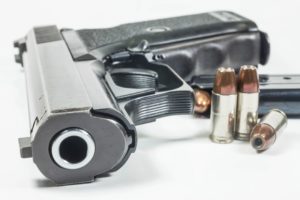
Concealed Carry on Campus
Podcast by Daniel Barwick
Independence Community College was the first public college in Kansas to allow concealed carry of handguns. I’m often asked by administrators from other states, researchers, and people with strong opinions about firearms about how this came about on our campus, and what issues we faced in doing so.
Want to hear this post as a podcast? You can listen below. Otherwise, just scroll down!
I should say right up front that the work that I’ve done in this area over the last couple of years has been helped immensely through a partnership with Matt Franz of Clark State Community College, who did a great deal of research work in this area, and who has partnered with me on a number of presentations regarding this issue – you can see some coverage of that here. If you are interested in seeing the detailed results of Matt’s work, he’d be happy to share them with you.
Obviously, this is a growing issue across the United States. At this point all 50 states have provisions for individual concealed carry somewhere in public. About 13 states ban weapons on campus. About 25 states leave the question of campus carry policy to the institution. And about a dozen states require campuses to permit concealed carry in some form or another by law.
Kansas falls into that last group. In 2013, the state of Kansas implemented a law in which campuses were required to either allow concealed carry or to provide adequate security for everyone. “Adequate security” was defined as metal detectors and armed guards at every entrance. (Obviously, given the number of buildings and entrances on college campuses, providing adequate security was not an option.)
It’s important to note the underlying theory for the new law: The lawmakers who initiated this believed strongly that people have a right to defend themselves, and if an institution was going to interfere with that right, then it had a responsibility to provide the security that the individual could no longer provide for himself or herself.
The new law did allow colleges to exempt themselves for a period of up to four years, as they prepared for implementation of the law. Independence Community College did not seek the exemption, for several reasons:
First, a significant number of the trustees of the college believed strongly in the right to individuals’ self-protection.
Second, there was some evidence that indicated that students or employees were already carrying concealed weapons. (With no incidents.)
Third, although many colleges had requested the exemption based on the belief that ultimately the law would be rolled back, my board did not believe that, and so a stall tactic was seen as pointless.
Fourth, and perhaps most importantly, the culture in rural southeast Kansas was receptive to the presence of weapons in general. Surveys of our students found an overwhelming number were either supportive of conceal carry or neutral on the subject. Our employees were slightly less enthusiastic, but surveys showed that the majority of them were either supportive or neutral. When the board held a public forum on the topic, only a couple of people spoke out against concealed carry.
Although Dr. Franz’s research shows that institutions that implement concealed carry often take as much as a year to fully develop a policy, and that those policies can be often as long as four pages, ICC made the decision in just a couple of months, and the eventual policy was only one sentence long: that we follow the state law regarding conceal carry of firearms.
The experience was especially interesting for me: having moved to Kansas from New York, and having gone through this experience shortly after arriving, I think that I still saw the issue of weapons through the lens that I had acquired in a more urban setting. I was, of course, very careful not to impose any views that I had on the process. The outcome of the policy has been for me, both interesting and relieving: as of this writing, we have not had a single firearms incident on the campus since the policy was enacted, whether related to the policy change or not. I sincerely hope that record will continue.
That outcome stands in stark contrast to the predictions of those who are opposed to concealed carry on campus. Although adoption of the new policy had no noticeable effect on our campus, I continued to be contacted regularly by researchers who are trying to determine the effect of such policies on campus safety. They were often obviously disappointed to find that there has been no measurable effect as a result of this policy.
After reflecting on my own experiences and after reviewing Dr. Franz’s research, I think there are two significant takeaways for administrators:
First, culture dictates timeframe. Our policy was created relatively quickly because the culture did not actively oppose the creation of the policy. But in cultures where the responses more negative, every effort should be made to take the time to listen carefully to the objections and to incorporate people‘s concerns into the final policy.
Second, it is pretty clear from the research that some unpopular policies become more palatable the longer they take to develop. Dr. Franz’s research includes anecdotes from campus presidents in which they share that resistance to the new policy decreased if the policy took a long time to develop, as if people simply became fatigued with the subject matter or tired of fighting. This is a pretty interesting outcome, I think – we have a tendency to think that an unpopular policy should be hurriedly shepherded through the process before significant opposition can coalesce; however, it may be that certain issues require the opposite approach, and it would be interesting to think about which issues those might be!